Mediterranean Folkdances
페이지정보
글쓴이 지중해지역원 조회 11,047 조회 날짜 24-07-05 11:23내용
Mediterranean Folkdances
IMS_Motahare Mozafari(HK research professor)
Folklore is a term that encompasses the traditions, stories, and cultural elements passed down within communities through generations. It includes tales, music, dances, rituals, proverbs, and even jokes that are not typically written down but shared orally or through practice. These elements of folklore are significant to a community’s identity, often reflecting its history, beliefs, values, and norms. Folklore helps to define a group’s identity, giving members a sense of belonging and continuity with their ancestors. It acts as a historical record, preserving knowledge of how people lived, thought, and interacted with their environment. Furthermore, folklore influences various art forms, including literature, film, and music, often serving as a source of inspiration and creativity.
Mediterranean folkloric dance is a vibrant tradition that reflects the diverse cultures of the Mediterranean region. Characterized by their lively rhythms, expressive movements, and colorful costumes, these dances vary from one locality to another. Typically performed at social gatherings, festivals, and celebrations, they serve as a means of communal expression and storytelling. The dances have been shaped by the various civilizations that have inhabited the Mediterranean, including Greek, Roman, Arab, and Ottoman influences. Live music is an integral part of these performances, and the dances often include gestures and steps that symbolize aspects of daily life, such as work, nature, or love. Performers wear traditional costumes that are elaborately decorated and colorful, adding to the visual spectacle of the dance. These dances not only entertain but also preserve the history and traditions of the Mediterranean people, passing them down through generations and across borders.
Here, we will explore three folkloric dances from different regions in the Mediterranean: Italy in South Europe, Morocco in North Africa, and the Levant (an ancient region known as Lebanon, Syria, Palestine, and Jordan) in West Asia.
Tarantella, Italian Folkdance
The Tarantella is a fascinating folkloric dance, deeply rooted in the culture of Southern Italy. Characterized by fast-paced, energetic movements, it embodies the essence of Italian folklore and is often accompanied by lively music in a 6/8 time signature. The origins of the Tarantella are connected to tarantism, a condition believed to be caused by the bite of a tarantula spider. During the 15th to 17th centuries, victims known as 'tarantati' were thought to be cured by engaging in frenzied dancing. This 'wild' dance would continue until the afflicted person was believed to have sweated out the spider’s venom.
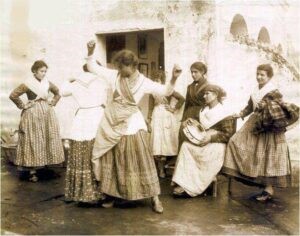
Women performing the traditional Italian Tarantella dance in an old village setting
From its supposed medicinal beginnings, the Tarantella has evolved into a symbol of celebration, often performed at weddings and festivals, turning into a cultural heritage marker. It represents a form of flirtation and courtship, with dancers engaging in teasing and playful interactions. Women traditionally carry tambourines, adding a rhythmic element to the dance. Today, the Tarantella remains a popular dance not only in Italy but also among Italian communities worldwide. It serves as a vibrant reminder of the region’s history and traditions and continues to be an important part of cultural celebrations. The dance has also been adapted by classical composers and has influenced other art forms.
The Tarantella includes various themes such as the celebration of life and community, healing and transformation both physically and emotionally, love and courtship, and cultural identity and resistance. Each movement in the Tarantella can carry symbolic meaning, from the representation of a spider's bite to the expression of human emotions like joy, fear, or desire.
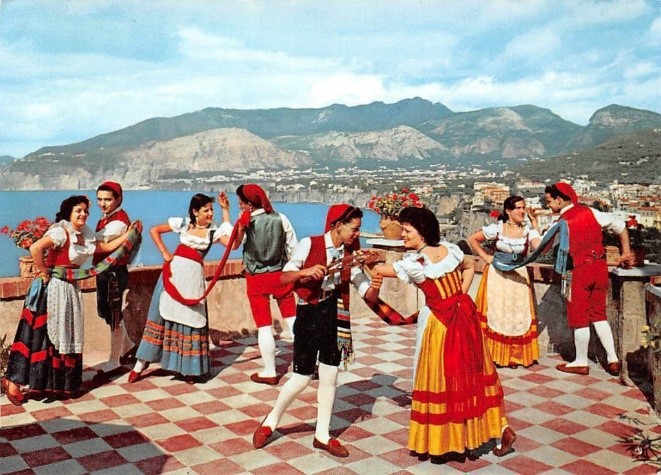
Dancers in vibrant traditional costumes perform the Tarantella
The music of the Tarantella is upbeat and lively, typically in a 6/8 time signature, which gives the dance its characteristic quick tempo. The use of traditional instruments like tambourines, mandolins, and accordions adds to the festive atmosphere of the dance. Women often carry tambourines, which they rhythmically tap to the beat of the music, serving not only as musical instruments but also as accessories that enhance the visual appeal of the dance. Moreover, traditional costumes are an important element of the Tarantella. Women typically wear colorful dresses with aprons and shawls, while men wear vests, sashes, and sometimes hats. The costumes add to the cultural significance of the dance and help to tell the story of the region’s heritage.
Another significant element of any folkloric dance is the representation of costume. In the Tarantella, women typically wear a white, gathered skirt with a white apron. The skirt is often full and flowing, allowing for freedom of movement during the dance. The blouse is usually white and may have puffed sleeves or delicate embroidery that adds to the costume’s traditional look. An embroidered scarf is often tied around the neck, adding color and detail to it. Men generally wear black or dark slacks that end below the knee, paired with a white shirt. A vest, often made of velvet or wool, is worn over the shirt. The vest may be adorned with decorative buttons or embroidery.
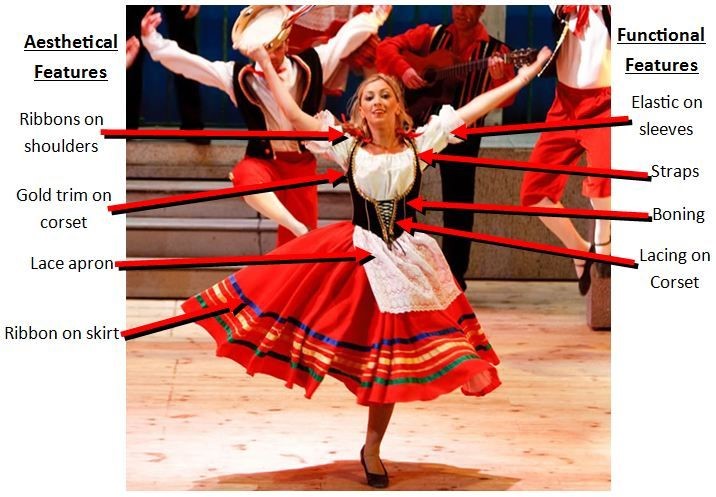
Gnawa, Moroccan Folkdance
The Gnawa dance of Morocco is more than just an art form; it's a deep cultural and spiritual practice that goes beyond simple artistic expression. It is deeply rooted in the history and traditions of the Gnawa people, who are descendants of West African slaves brought to Morocco. The dance forms part of the larger Gnawa music tradition, which is a fusion of African, Berber, and Arabic spiritual and musical cultures.
The Gnawa culture originated from the Gnawa people’s ancestral homeland in West Africa, and the dance reflects the rich heritage and resilience of these communities.The dance is a key part of ‘Lila’, a ritual that lasts all night and includes music, dance, and chants to help people enter a dream for healing and spiritual communication. Participants in Gnawa ceremonies seek spiritual healing and purification, often believed to be possessed by spirits or seeking blessings from ancestors. The Gnawa tradition, including its music and dance, was inscribed in 2019 on the UNESCO Representative List of the Intangible Cultural Heritage of Humanity, highlighting its importance as a cultural treasure.

The Gnawa Group of Oued Toudra, Tinghir, Morocco.
The dance is a celebration of life, community, and spiritual connection, embodying the collective memory and identity of the Gnawa people. It serves as a living link to the past, a form of cultural preservation, and a testament to the enduring spirit and cultural richness of Morocco. A primary aspect of the Gnawa dance is the induction of trance states, where participants may become vessels for spirits or ancestors. This concept of spirit possession is central to the dance’s transformative power.
The Gnawa dance is a vital part of Moroccan cultural heritage, representing the resilience and adaptability of the Gnawa people. It serves as a living memory of their history and a continuation of their ancestral traditions. The dance is not only performed for entertainment but is primarily a part of Lila ceremonies—whole-night rituals that combine healing, spirituality, and community bonding.
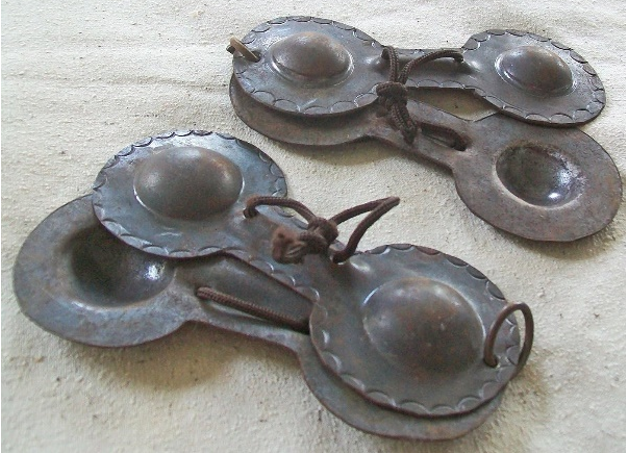
Pair of Morrocan Gnawa Traditional Iron Castanets
The representation of the costume in Gnawa dance is also very special in its place. The primary garment worn by Gnawa performers is a long, flowing robe known as a ‘djellaba.’These robes are often made from colorful fabrics and may include patterns or embroidery. Gnawa performers often wear a cap that is heavily adorned with cowrie shells, beads, and sometimes colorful tassels. The cap is not only a significant part of the visual presentation but also holds spiritual significance, as it is believed to protect the wearer from evil spirits during the trance-like states that are induced during performances. Also, decorative belts or sashes are worn on their waists. These are usually also decorated with beads, shells, and other amulets, which serve as spiritual protections and are thought to have healing powers. It is common for Gnawa performers to wear various amulets and talismans. These items are believed to have protective and healing properties, warding off bad spirits and bringing good fortune.
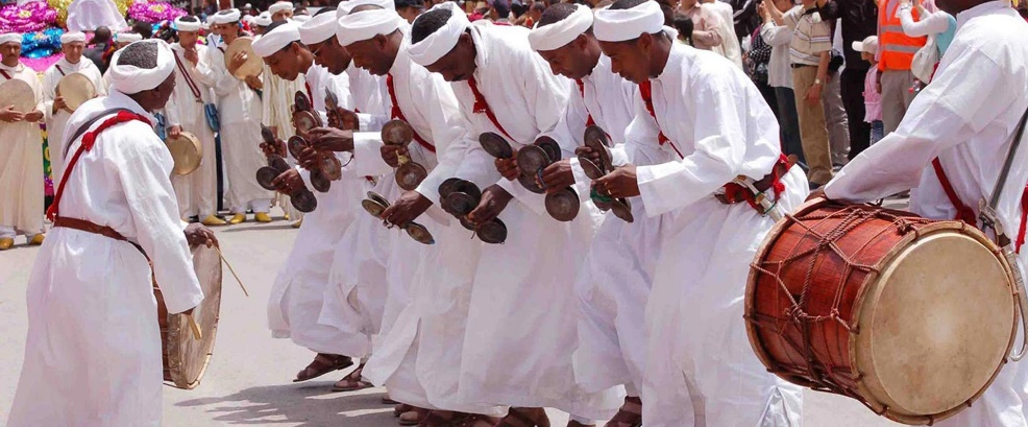
Dabke, Levantine (Palestine, Syria, Lebanon, Jordan) Folkdance
Dabke is indeed a vibrant and significant part of the cultural heritage in the Levant. It’s a dance that symbolizes joy, unity, and the communal spirit of the people. The dance involves a combination of circle and line dancing, where participants hold hands or shoulders and perform a series of steps that include stomping, jumping, and kicking. The line is usually led by a dancer called the ‘lawweeh’, who is skilled in improvisation and leads the group with a variety of moves.
The origins of Dabke are believed to be ancient, with some theories suggesting it started as a way of compacting the roofs of houses made of mud by stomping the feet together. Over time, it evolved into the celebratory dance today, often performed at weddings, festivals, and other joyous occasions.
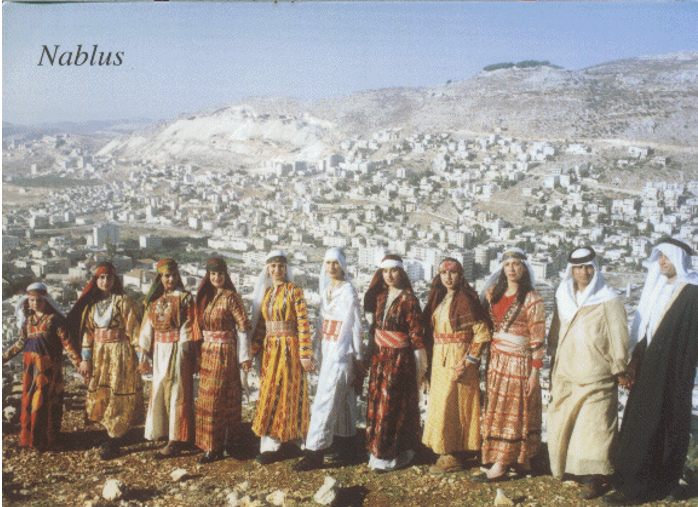
Dabkeh band on Mount Gerizim in Nablus
Each country in the Levant has its own variation of Dabke, reflecting the local culture and traditions. For instance, the ‘Al-Shamaliyya’ style is common, where the dance begins with a musician playing a solo on traditional instruments like the mijwiz or yarghoul, accompanied by singers. As the dance progresses, others join in, and the movements become more synchronized and complex.
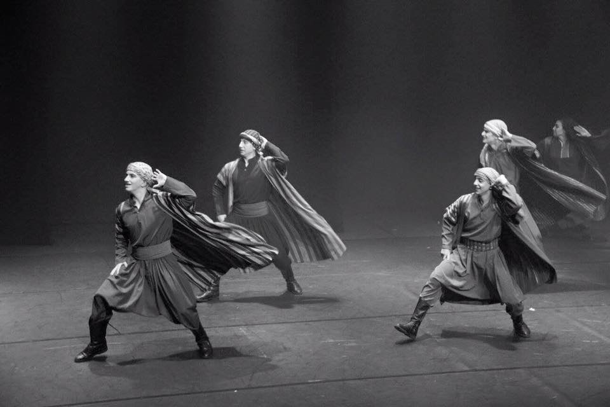
Palestinian men dancing dabke
Dabke is not just a dance; it’s a form of expression that has been used for political expression and social commentary as well. It’s a dance that brings people together, creating a sense of community and shared identity among the participants. Whether it’s the intricate footwork, the rhythmic clapping, or the lively music, Dabke remains a powerful symbol of the cultural richness of the Levantine people. Dabke embodies themes of unity, strength, and pride. It is performed in a line or a circle, with dancers linking arms or holding hands, symbolizing strength and unity among the participants. It is traditionally performed at weddings, festivals, and significant social occasions.
The dance includes a variety of stomping, tapping, and kicking movements, which traditionally helped to compact the roofs of houses. Dancers often incorporate jumps and high kicks, which add to the energetic and dynamic nature of the dance. Often, a leader (called the "Lawweeh" or "Raas") controls the movement of the line or circle, introducing variations and dictating the pace and form of the dance.
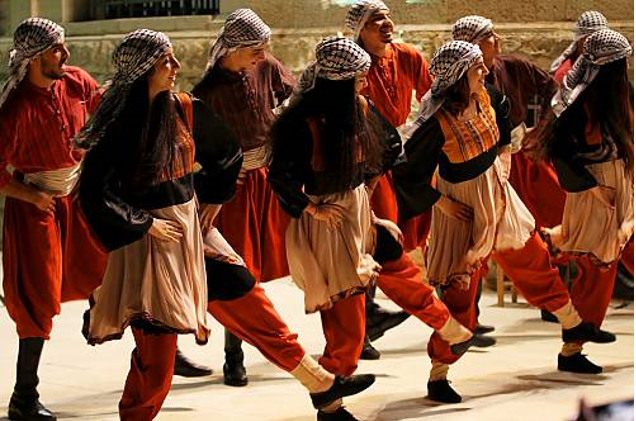
The costumes worn during Dabke performances are traditional and colorful. Men typically wear a ‘Sherwal’ (baggy trousers) and a long-sleeved shirt, often topped with a ‘Tarboush’(fez) or a ‘Keffiyeh’ (headscarf). A sash may also be worn around the waist. Women often wear long, embroidered dresses called ‘Thobes’, which are adorned with traditional patterns and vibrant colors.
Dabke is often performed during national celebrations and has also been used as a form of cultural and political expression. The dance has transcended its local origins to gain popularity across the world, wherever diaspora communities from the Levant have settled.
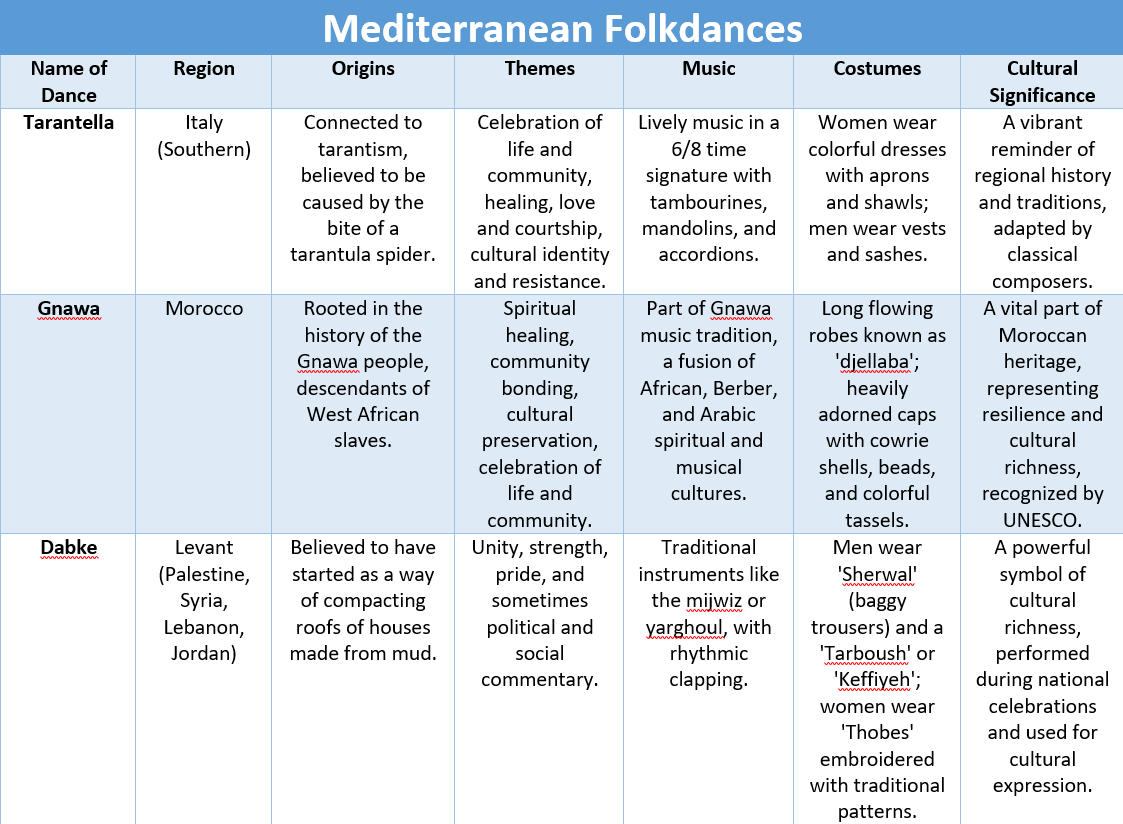
References
Bernasek, L & Burger, H. S. (2008) Imazighen!: Beauty and Artisanship in Berber Life, Peabody Museum Press
Ennaji, M (2005) Multilingualism, Cultural Identity and Education in Morocco, Springer, New York, USA
Handelsman, JoEllen. 3, Dance Styles of the Middle East. "Near and Middle Eastern Dance Workbook." 2nd ed. Tucson: Premium Source, 2012.
Inserra, Incoronata. 2017. Global Tarantella: Reinventing Southern Italian Folk Music and Dances. Urbana-Champaign: University of Illinois Press.
Kaschl, Elke. Dance and Authenticity in Israel and Palestine: Performing the Nation. Leiden & Boston, MA: Brill; 2003.
Photos links:
https://journeythroughitaly.com/tarantella/
https://adhstudiotds.wordpress.com/2019/01/20/the-tarentella/
https://southeast-morocco.com/the-living-heritage-of-the-gnawa-of-lalla-mimouna/
https://www.amazon.com/Fair-Trade-Set-Traditional-Castanets/dp/B00NESX6I8
https://en.wikipedia.org/wiki/Dabke#/media/File:Dabkeh.png
https://en.wikipedia.org/wiki/Dabke#/media/File:Palestinian_Dabke.jpg
https://ich.unesco.org/en/RL/dabkeh-traditional-dance-in-palestine-01998
댓글목록
댓글이 없습니다
